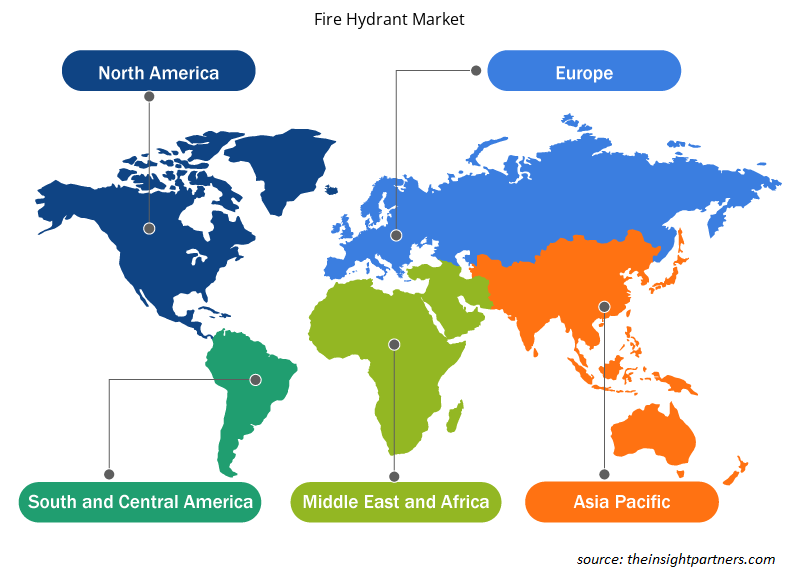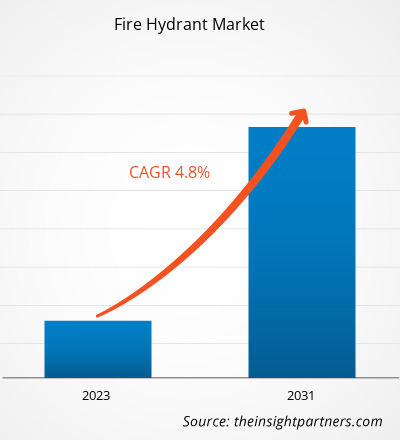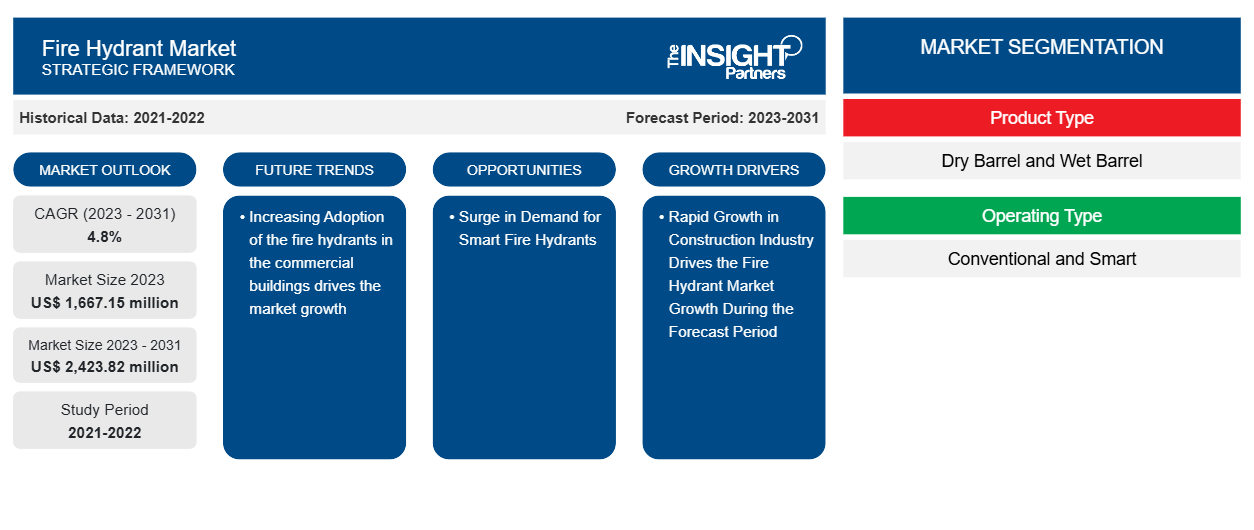Das Marktvolumen für Hydranten soll von 1.667,15 Millionen US-Dollar im Jahr 2023 auf 2.423,82 Millionen US-Dollar im Jahr 2031 anwachsen. Für den Zeitraum 2023–2031 wird eine durchschnittliche jährliche Wachstumsrate (CAGR) von 4,8 % erwartet.
Ein Hydrant ist eine exklusive Lagereinrichtung zur Lagerung temperaturempfindlicher Waren oder Produkte, häufig verderblicher Artikel, darunter Tiefkühlkost, Frischwaren und pharmazeutische Produkte. Hydrant-Einrichtungen tragen dazu bei, die Unversehrtheit, Frische und Sicherheit verderblicher Produkte zu gewährleisten.
Die steigende Vorliebe der Verbraucher für verarbeitete und leicht zuzubereitende Konserven steigert die Nachfrage nach Hydrantenanlagen. Darüber hinaus profitieren auch die zunehmende Akzeptanz des Omnichannel-Lebensmitteleinkaufs und die Verbreitung des Online-Shoppings vom weltweiten Hydrantenmarkt. Verbraucher erwägen den Online-Einkauf von Lebensmitteln, da dies sicher ist und Zeit spart. Der boomende Lebensmittel- und Getränkesektor aufgrund der wachsenden Nachfrage nach Konserven und Tiefkühlprodukten sowie die Entwicklung im Pharmasektor treiben den globalen Hydrantenmarkt ebenfalls an.
Marktanalyse für Feuerhydranten
Das Marktwachstum wird auf die zunehmende Urbanisierung und den Bau von Gewerbe- und Industriegebäuden sowie auf das weit verbreitete Bewusstsein für den Schutz von Vermögenswerten zurückgeführt. Die zunehmenden staatlichen Vorschriften, die den Einbau von Brandschutzsystemen in Wohn- und Nichtwohngebäuden fördern, dürften das Wachstum des Hydrantenmarktes in den kommenden Jahren beschleunigen. Bei intelligenten Hydranten können Sensoren oder künstliche Intelligenz (KI) zur Steuerung der Systeme eingesetzt werden.
Marktübersicht für Hydranten
Hydrantensysteme sind wichtige Werkzeuge, die in verschiedenen Unternehmen oder Produktionsstätten zum Löschen eines Feuers benötigt werden. Ein Hydrantensystem besteht aus einem Wasserdrucksystem, das über Rohre und Schläuche im gesamten Gebäude verteilt ist. Diese Systeme umfassen Wasserspeichertanks, Pumpen, Rohrleitungen und Ventile, Feuerwehrverstärker, Hydranten, Landeventile, Kupplungen, flach liegende Feuerwehrschläuche und Blockpläne. Der Betrieb von Hydrantensystemen erfolgt nach dem Prinzip des Druckabfalls. Der Wasserdruck fällt ab, wenn der Bediener das Hydrantenventil öffnet. Der Druckschalter aktiviert die Druckerhöhungspumpe, um diesem Effekt entgegenzuwirken, die mehr Wasser aus der Quelle entnimmt, um den Druck des Systems zu erhöhen. Dieses unter Druck stehende Wasser mit einem Druck von 7–10 Bar wird dann zum Brandherd geleitet, um ihn zu löschen. Die Hydrantensysteme werden anhand ihrer Antriebskonfigurationen klassifiziert, z. B. Diesel-, Elektro- und Hybridantriebssysteme. Die Modelle mit Diesel-, Elektro- und Hybridantrieb verwenden Diesel, Strom bzw. eine Kombination aus beiden als Kraftstoff für den Betrieb des Hydrantensystems. Darüber hinaus können diese Systeme durch Automatisierung viel effektiver gemacht werden, da für die Bedienung eines Hydrantensystems immer ein oder zwei Personen erforderlich sind.
Passen Sie diesen Bericht Ihren Anforderungen an
Sie erhalten kostenlos individuelle Anpassungen an jedem Bericht, einschließlich Teilen dieses Berichts oder einer Analyse auf Länderebene, eines Excel-Datenpakets sowie tolle Angebote und Rabatte für Start-ups und Universitäten.
-
Holen Sie sich die wichtigsten Markttrends aus diesem Bericht.Dieses KOSTENLOSE Beispiel umfasst eine Datenanalyse von Markttrends bis hin zu Schätzungen und Prognosen.
Treiber und Chancen auf dem Hydrantenmarkt
Schnelles Wachstum in der Bauindustrie treibt das Wachstum des Hydrantenmarktes im Prognosezeitraum an
Das Wachstum des Hydrantenmarktes ist auf die schnell wachsende Bauindustrie zurückzuführen, die mit der wachsenden Weltbevölkerung und Urbanisierung einhergeht. Die Länder, darunter Mexiko, die USA, Kanada, Deutschland und Frankreich, haben mit staatlicher Unterstützung und Initiativen erhebliche Investitionen in Neubau- und Infrastrukturentwicklungsprojekte getätigt. Der Anstieg der Bauarbeiten im Wohn- und Gewerbesektor aufgrund der zunehmenden Urbanisierung treibt das Wachstum des Hydrantenmarktes voran.
Der globale Markt für Wohngebäude, einschließlich Neubauten, Renovierungen und Umbauten, wurde laut dem Bericht der Ceramics Organization im Jahr 2022 auf 6,80 Billionen US-Dollar geschätzt. Regierungsstellen legen zusätzlichen Wert auf die Stärkung des Bauwesens und der Infrastrukturentwicklung, was die Nachfrage auf dem Hydrantenmarkt weiter ankurbelt. Laut Global Construction 2030 wird das Volumen der Bauproduktion bis 2030 weltweit voraussichtlich um 85 % auf 15,5 Billionen US-Dollar steigen. Die USA, Japan und Indien haben den größten Anteil und verzeichnen im Prognosezeitraum das höchste CAGR-Wachstum. Darüber hinaus fördern Investitionen in die Renovierung alter Gebäude und Strukturen sowie strengere staatliche Vorschriften und Bestimmungen zur Gebäudesicherheit das Wachstum des Hydrantenmarktes weiter.
Steigende Nachfrage nach intelligenten Hydranten
Intelligente Hydranten ermöglichen es der Wasserwirtschaft, Problemen immer einen Schritt voraus zu sein, indem sie ein vollständiges Bild ihrer Verteilungsnetze liefern. Mit diesem Wissen können Versorgungsunternehmen Geld sparen, indem sie Problemen vorbeugen, und die Kundenbindung steigern, indem sie ihnen das Leben erleichtern. Der intelligente Hydrant kann Geld sparen, indem er Lecks wesentlich schneller und effizienter erkennt als aktuelle Ansätze. Obwohl Versorgungsunternehmen bekannte Problemstellen wie große Kreuzungen regelmäßig überwachen, kann ein kleines Leck lange Zeit unentdeckt bleiben, bis es groß genug wird, um den Wasserdruck zu unterbrechen, Straßen zu erodieren oder einen erheblichen Rohrbruch auszulösen. Ein intelligenter Hydrant kann eine systemweite tägliche Überwachung ermöglichen. Wenn das Personal zur Leckerkennung effizienter arbeiten kann, kann das Versorgungsunternehmen auch seinen CO2-Fußabdruck verringern. Unbefugte Hydrantenöffnungen können auch von intelligenten Hydranten erkannt werden, die die Versorgungsunternehmen informieren können. Intelligente Hydranten könnten die Wasserverschwendung aufgrund von Lecks im Versorgungssystem erheblich verringern, aber es bleibt immer noch die Frage des individuellen Wasserverbrauchs zu berücksichtigen.
Segmentierungsanalyse des Hydrantenmarktberichts
Wichtige Segmente, die zur Ableitung der Hydrantenmarktanalyse beigetragen haben, sind Produkttyp, Betriebsart, Konstruktion und Anwendung.
- Basierend auf dem Produkttyp wird der Markt in Trockenfässer und Nassfässer unterteilt. Trockenfässer dominieren den Markt aufgrund der zunehmenden Verbreitung in Gebieten mit Minustemperaturen. Auch der Rostschutz und der geringere Wartungsaufwand im Vergleich zu Nassfässern fördern das Segmentwachstum. Der niedrige Preis eines Nassfässer-Hydranten und der einfache Zugang bei normalen atmosphärischen Temperaturbedingungen unterstützen jedoch sein Wachstum. Die Einführung von Trocken- und Nassfässer-Hydranten hängt in erster Linie von den Anforderungen der Umgebungsbedingungen ab.
- Je nach Betriebsart wird der Markt in konventionelle und intelligente Hydranten unterteilt. Konventionelle Hydranten dominieren den Markt aufgrund ihrer hohen Marktdurchdringung. Die steigende Nachfrage nach Wasserdatenüberwachung beschleunigt jedoch das Wachstum im Segment der intelligenten Hydranten.
- Basierend auf der Bauweise wird der Markt in unterirdische und oberirdische Bauten unterteilt.
- Je nach Endverbraucher wird der globale Hydrantenmarkt in gewerbliche und industrielle Hydranten unterteilt.
Marktanteilsanalyse für Hydranten nach geografischer Lage
Der geografische Umfang des Hydrantenmarktberichts ist hauptsächlich in fünf Regionen unterteilt: Nordamerika, Asien-Pazifik, Europa, Naher Osten und Afrika sowie Südamerika/Süd- und Mittelamerika.
Der asiatisch-pazifische Raum umfasst Entwicklungsländer wie China, Indien, Singapur und Vietnam sowie andere südöstliche Länder und Industrieländer wie Japan und Australien. Die Fertigungsindustrien in den asiatischen Ländern wachsen exponentiell. Darüber hinaus werden steigende Investitionen in die Bauindustrie von Regierungsbehörden in Indien, China und anderen asiatisch-pazifischen Ländern das Wachstum der Industrie-, Wohn- und Gewerbesektoren beschleunigen und damit erhebliche Wachstumschancen für die Akteure auf dem Hydrantenmarkt schaffen.
Regionale Einblicke in den Hydrantenmarkt
Die regionalen Trends und Faktoren, die den Hydrantenmarkt im Prognosezeitraum beeinflussen, wurden von den Analysten von Insight Partners ausführlich erläutert. In diesem Abschnitt werden auch die Marktsegmente und die Geografie des Hydrantenmarkts in Nordamerika, Europa, im asiatisch-pazifischen Raum, im Nahen Osten und Afrika sowie in Süd- und Mittelamerika erörtert.

- Erhalten Sie regionale Daten zum Hydrantenmarkt
Umfang des Marktberichts zu Hydranten
| Berichtsattribut | Details |
|---|---|
| Marktgröße im Jahr 2023 | 1.667,15 Millionen US-Dollar |
| Marktgröße bis 2031 | 2.423,82 Millionen US-Dollar |
| Globale CAGR (2023 - 2031) | 4,8 % |
| Historische Daten | 2021-2022 |
| Prognosezeitraum | 2023–2031 |
| Abgedeckte Segmente |
Nach Produkttyp
|
| Abgedeckte Regionen und Länder |
Nordamerika
|
| Marktführer und wichtige Unternehmensprofile |
|
Marktteilnehmerdichte: Der Einfluss auf die Geschäftsdynamik
Der Markt für Hydranten wächst rasant, angetrieben durch die steigende Nachfrage der Endnutzer aufgrund von Faktoren wie sich entwickelnden Verbraucherpräferenzen, technologischen Fortschritten und einem größeren Bewusstsein für die Vorteile des Produkts. Mit steigender Nachfrage erweitern Unternehmen ihr Angebot, entwickeln Innovationen, um die Bedürfnisse der Verbraucher zu erfüllen, und nutzen neue Trends, was das Marktwachstum weiter ankurbelt.
Die Marktteilnehmerdichte bezieht sich auf die Verteilung der Firmen oder Unternehmen, die in einem bestimmten Markt oder einer bestimmten Branche tätig sind. Sie gibt an, wie viele Wettbewerber (Marktteilnehmer) in einem bestimmten Marktraum im Verhältnis zu seiner Größe oder seinem gesamten Marktwert präsent sind.
Die wichtigsten auf dem Hydrantenmarkt tätigen Unternehmen sind:
- Amerikanische Cast Iron Company
- AVK International A/S
- BOCCIOLONE ANTINCEDIO
- EJ Group, Inc
- IMP Armature doo
- Kupferle Gießerei GmbH
Haftungsausschluss : Die oben aufgeführten Unternehmen sind nicht in einer bestimmten Reihenfolge aufgeführt.

- Überblick über die wichtigsten Akteure auf dem Hydrantenmarkt
Neuigkeiten und aktuelle Entwicklungen zum Hydrantenmarkt
Der Markt für Hydranten wird durch die Erhebung qualitativer und quantitativer Daten nach Primär- und Sekundärforschung bewertet, die wichtige Unternehmensveröffentlichungen, Verbandsdaten und Datenbanken umfasst. Im Folgenden finden Sie eine Liste der Entwicklungen auf dem Markt für Innovationen, Geschäftserweiterungen und Strategien:
- Im März 2024 richtete die Public Service Commission des US-Bundesstaates West Virginia eine Task Force ein, die sich um defekte Hydranten kümmern sollte, da drei Hydranten in dem abgebrannten Haus in Charleston kein Wasser lieferten. Die Hausbesitzer reichten Klage gegen den Wasserversorger West Virginia American Water ein. (Quelle: Eurofins, Pressemitteilung)
- Im Juni 2022 schloss die AVK Holding Company die Übernahme der in Großbritannien ansässigen TALIS Group ab. Das Unternehmen stellt Hydranten und andere Baugeräte her und firmiert unter dem Namen Atlantic Plastics Ltd.
Marktbericht zu Feuerhydranten – Umfang und Ergebnisse
Der Bericht „Marktgröße und Prognose für Hydranten (2021–2031)“ bietet eine detaillierte Analyse des Marktes, die die folgenden Bereiche abdeckt:
- Hydrantenmarktgröße und -prognose auf globaler, regionaler und Länderebene für alle wichtigen Marktsegmente, die im Rahmen des Berichts abgedeckt sind
- Marktdynamik wie Treiber, Beschränkungen und wichtige Chancen
- Markttrends für Hydranten
- Detaillierte PEST-Analyse und SWOT-Analyse
- Marktanalyse für Hydranten, die wichtige Markttrends, globale und regionale Rahmenbedingungen, wichtige Akteure, Vorschriften und aktuelle Marktentwicklungen abdeckt.
- Markt für Hydranten: Branchenlandschaft und Wettbewerbsanalyse, einschließlich Marktkonzentration, Heatmap-Analyse, prominenten Akteuren und aktuellen Entwicklungen.
- Detaillierte Firmenprofile
- Historische Analyse (2 Jahre), Basisjahr, Prognose (7 Jahre) mit CAGR
- PEST- und SWOT-Analyse
- Marktgröße Wert/Volumen – Global, Regional, Land
- Branchen- und Wettbewerbslandschaft
- Excel-Datensatz
Aktuelle Berichte
Erfahrungsberichte
Grund zum Kauf
- Fundierte Entscheidungsfindung
- Marktdynamik verstehen
- Wettbewerbsanalyse
- Kundeneinblicke
- Marktprognosen
- Risikominimierung
- Strategische Planung
- Investitionsbegründung
- Identifizierung neuer Märkte
- Verbesserung von Marketingstrategien
- Steigerung der Betriebseffizienz
- Anpassung an regulatorische Trends























 Kostenlose Probe anfordern für - Markt für Hydranten
Kostenlose Probe anfordern für - Markt für Hydranten